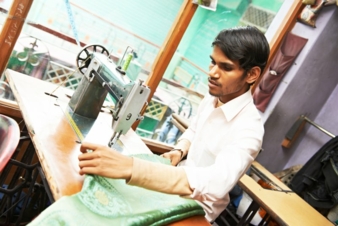31/01/2019 – Germany Trade & Invest — auf Deutsch lesen
India: Textile and Clothing Industry with Potential of Modernization
Structural weaknesses and fiscal reforms have afflicted the Indian textile sector. Modernization and diversification are necessary. Supportive measures have been taken in this regard.
During the marketing year 2016/17 (April 1 to March 31), the government of India has launched some fundamental reforms like the introduction of a countrywide uniform goods and services tax (GST) as well as a partial currency devaluation. These measures were meant to support the total economy in the medium to long term. Yet, they provoked unsettledness and difficulties in some sectors, especially in the textile industry. Additionally, cotton prices have been on a high level.
The existence of an own textile ministry demonstrates the importance of this sector for India, not only for generating foreign currencies, but also as employer. In 2017, the whole sector including spinning, weaving up to clothing and other finished products contributed about 14 percent to the added value of the processing industry and generated 13 percent of all foreign currency revenues. Moreover, the sector employed 40 million people directly and 60 million indirectly. India as a globally leading producer of cotton as well as jute and silk has got comparative advantages in the textile sector and can look back on a long tradition in processing.
On the one hand, India’s textile industry enjoys cost advantages compared to industrialized countries and advanced developing countries like China. On the other hand, some smaller developing countries have become notable competitors in the meantime. Bangladesh and Vietnam, for example, export a lot more apparelthan India. These smaller competitors have aligned their apparel manufacturing industry with export markets and modernized correspondingly, since they haven’t got great domestic markets. Representatives of the sector talking to GTAI noted, however, that the Indian textile manufacturers have access to a strongly growing domestic market of 1.3 billion inhabitants in case the quality is not sufficient for export purposes.
The clothing industry of India still shows a large potential of modernization. New production techniques are necessary to improve the companies’ performance in particular. The fragmentation of the clothing industry is a further disadvantage.
The spinning and weaving sector has been more up-to-date. Industry experts attest this sector a top position globally in terms of size, technology, productivity, quality and price. This applies to the machinery import as well. The association for textile machinery of the German Mechanical Engineering Industry Association VDMA reported that India has been the major export market for German spinning equipment, followed by China, and the fifth largest market for weaving machines in 2017. Yet, relating to textile finishing equipment, India does not belong to the first six export markets in contrast to its competitor Bangladesh.
Source: Germany Trade & Invest
Excerpt from the Bremen Cotton Report No. 03/04 – January 24th, 2019.
For more information www.gtai.de/GTAI/Navigation/EN/welcome.html




